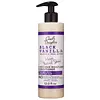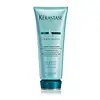What's inside
What's inside
 Key Ingredients
Key Ingredients

 Benefits
Benefits

 Concerns
Concerns

 Ingredients Side-by-side
Ingredients Side-by-side

Water
Skin ConditioningCetearyl Alcohol
EmollientGlycerin
HumectantBehentrimonium Methosulfate
Dimethicone
EmollientStearamidopropyl Dimethylamine
EmulsifyingParfum
MaskingPolysorbate 60
EmulsifyingAmodimethicone
Divinyldimethicone/Dimethicone Copolymer
Guar Hydroxypropyltrimonium Chloride
Skin ConditioningPhenoxyethanol
PreservativeDicetyldimonium Chloride
EmulsifyingCaprylyl Glycol
EmollientPolyquaternium-37
Citric Acid
BufferingCetrimonium Chloride
AntimicrobialDicaprylyl Carbonate
EmollientBenzyl Salicylate
PerfumingCoumarin
PerfumingPotassium Sorbate
PreservativeVp/Dmapa Acrylates Copolymer
Butyrospermum Parkii Butter
Skin ConditioningIsopropyl Alcohol
SolventPolyquaternium-7
Trideceth-15
EmulsifyingTrideceth-3
EmulsifyingHexylene Glycol
EmulsifyingBenzyl Alcohol
PerfumingPanthenol
Skin ConditioningTetrasodium Glutamate Diacetate
Alcohol Denat.
AntimicrobialC12-13 Pareth-23
CleansingC12-13 Pareth-3
EmulsifyingPolyurethane-14
Lauryl Glucoside
CleansingTocopherol
AntioxidantAmp-Acrylates Copolymer
Fumaric Acid
BufferingSodium Benzoate
MaskingRosa Canina Flower Extract
AstringentLavandula Angustifolia Flower Extract
CleansingUrtica Dioica Leaf Extract
Skin ConditioningRosmarinus Officinalis Leaf Extract
AntimicrobialTocopheryl Acetate
AntioxidantAscorbic Acid
AntioxidantCalendula Officinalis Flower Extract
MaskingMelilotus Officinalis Extract
AstringentSalvia Officinalis Extract
AntimicrobialBenzalkonium Chloride
AntimicrobialTrisodium Hedta
Vanilla Planifolia Fruit Extract
Skin ConditioningPEG-45m
HumectantBHT
AntioxidantWater, Cetearyl Alcohol, Glycerin, Behentrimonium Methosulfate, Dimethicone, Stearamidopropyl Dimethylamine, Parfum, Polysorbate 60, Amodimethicone, Divinyldimethicone/Dimethicone Copolymer, Guar Hydroxypropyltrimonium Chloride, Phenoxyethanol, Dicetyldimonium Chloride, Caprylyl Glycol, Polyquaternium-37, Citric Acid, Cetrimonium Chloride, Dicaprylyl Carbonate, Benzyl Salicylate, Coumarin, Potassium Sorbate, Vp/Dmapa Acrylates Copolymer, Butyrospermum Parkii Butter, Isopropyl Alcohol, Polyquaternium-7, Trideceth-15, Trideceth-3, Hexylene Glycol, Benzyl Alcohol, Panthenol, Tetrasodium Glutamate Diacetate, Alcohol Denat., C12-13 Pareth-23, C12-13 Pareth-3, Polyurethane-14, Lauryl Glucoside, Tocopherol, Amp-Acrylates Copolymer, Fumaric Acid, Sodium Benzoate, Rosa Canina Flower Extract, Lavandula Angustifolia Flower Extract, Urtica Dioica Leaf Extract, Rosmarinus Officinalis Leaf Extract, Tocopheryl Acetate, Ascorbic Acid, Calendula Officinalis Flower Extract, Melilotus Officinalis Extract, Salvia Officinalis Extract, Benzalkonium Chloride, Trisodium Hedta, Vanilla Planifolia Fruit Extract, PEG-45m, BHT
Water
Skin ConditioningBehentrimonium Chloride
PreservativeCetearyl Alcohol
EmollientCetyl Esters
EmollientPEG-180
HumectantIsononyl Isononanoate
EmollientElaeis Guineensis Oil
EmollientIsopropyl Alcohol
SolventMethylparaben
PreservativeHydroxyethylcellulose
Emulsion Stabilising2-Oleamido-1,3-Octadecanediol
Skin ConditioningBHT
AntioxidantChlorhexidine Digluconate
AntimicrobialButylphenyl Methylpropional
PerfumingAmyl Cinnamal
PerfumingBenzyl Alcohol
PerfumingCitric Acid
BufferingHexyl Cinnamal
PerfumingLinalool
PerfumingBenzyl Salicylate
PerfumingGlycerin
HumectantTrehalose
HumectantTamarindus Indica Seed Polysaccharide
Skin ConditioningCI 19140
Cosmetic ColorantCI 42090
Cosmetic ColorantMyrothamnus Flabellifolia Leaf Extract
EmollientParfum
MaskingWater, Behentrimonium Chloride, Cetearyl Alcohol, Cetyl Esters, PEG-180, Isononyl Isononanoate, Elaeis Guineensis Oil, Isopropyl Alcohol, Methylparaben, Hydroxyethylcellulose, 2-Oleamido-1,3-Octadecanediol, BHT, Chlorhexidine Digluconate, Butylphenyl Methylpropional, Amyl Cinnamal, Benzyl Alcohol, Citric Acid, Hexyl Cinnamal, Linalool, Benzyl Salicylate, Glycerin, Trehalose, Tamarindus Indica Seed Polysaccharide, CI 19140, CI 42090, Myrothamnus Flabellifolia Leaf Extract, Parfum
Ingredients Explained
These ingredients are found in both products.
Ingredients higher up in an ingredient list are typically present in a larger amount.
Benzyl Alcohol is most commonly used as a preservative. It also has a subtle, sweet smell. Small amounts of Benzyl Alcohol is not irritating and safe to use in skincare products. Most Benzyl Alcohol is derived from fruits such as apricots.
Benzyl Alcohol has both antibacterial and antioxidant properties. These properties help lengthen the shelf life of products. Benzyl Alcohol is a solvent and helps dissolve other ingredients. It can also improve the texture and spreadability.
Alcohol comes in many different forms. Different types of alcohol will have different effects on skin. This ingredient is an astringent alcohol.
Using high concentrations of these alcohols are drying on the skin. They may strip away your skin's natural oils and even damage your skin barrier. Astringent alcohols may also irritate skin.
Other types of astringent alcohols include:
According to the National Rosacea Society based in the US, you should be mindful of products with these alcohols in the top half of ingredients.
Any type of sanitizing product will have high amounts of alcohol to help kill bacteria and viruses.
Learn more about Benzyl AlcoholBenzyl Salicylate is a solvent and fragrance additive. It is an ester of benzyl alcohol and salicylic acid. This ingredient can be naturally found in some plants and plant extracts.
In fragrances, Benzyl Salicylate may be a solvent or a fragrance component. In synthetic musk scents, it is used as a solvent. For floral fragrances such as lilac and jasmine, it is used as a fragrance component. The natural scent of Benzyl Salicylate is described as "lightly-sweet, slightly balsamic".
While Benzyl Salicylate has been associated with contact dermatitis and allergies, emerging studies show it may not be caused by this ingredient alone.
However, this ingredient is often used with fragrances and other components that may cause allergies. It is still listed as a known allergen in the EU. We recommend speaking with a professional if you have concerns.
Another study from 2021 shows Benzyl Salicylate may have anti-inflammatory properties.
Learn more about Benzyl SalicylateBHT is a synthetic antioxidant and preservative.
As an antioxidant, it helps your body fight off free-radicals. Free-radicals are molecules that may damage your skin cells.
As a preservative, it is used to stabilize products and prevent them from degrading. Specifically, BHT prevents degradation from oxidation.
The concerns related to BHT come from oral studies; this ingredient is currently allowed for use by both the FDA and EU.
However, it was recently restricted for use in the UK as of April 2024.
Learn more about BHTCetearyl alcohol is a mixture of two fatty alcohols: cetyl alcohol and stearyl alcohol. It is mainly used as an emulsifier. Emulsifiers help prevent the separation of oils and products. Due to its composition, it can also be used to thicken a product or help create foam.
Cetearyl alcohol is an emollient. Emollients help soothe and hydrate the skin by trapping moisture.
Studies show Cetearyl alcohol is non-toxic and non-irritating. The FDA allows products labeled "alcohol-free" to have fatty alcohols.
This ingredient is usually derived from plant oils such as palm, vegetable, or coconut oils. There is debate on whether this ingredient will cause acne.
Due to the fatty acid base, this ingredient may not be Malassezia folliculitis safe.
Learn more about Cetearyl AlcoholCitric Acid is an alpha hydroxy acid (AHA) naturally found in citrus fruits like oranges, lemons, and limes.
Like other AHAs, citric acid can exfoliate skin by breaking down the bonds that hold dead skin cells together. This helps reveal smoother and brighter skin underneath.
However, this exfoliating effect only happens at high concentrations (20%) which can be hard to find in cosmetic products.
Due to this, citric acid is usually included in small amounts as a pH adjuster. This helps keep products slightly more acidic and compatible with skin's natural pH.
In skincare formulas, citric acid can:
While it can provide some skin benefits, research shows lactic acid and glycolic acid are generally more effective and less irritating exfoliants.
Most citric acid used in skincare today is made by fermenting sugars (usually from molasses). This synthetic version is identical to the natural citrus form but easier to stabilize and use in formulations.
Read more about some other popular AHA's here:
Learn more about Citric AcidGlycerin is already naturally found in your skin. It helps moisturize and protect your skin.
A study from 2016 found glycerin to be more effective as a humectant than AHAs and hyaluronic acid.
As a humectant, it helps the skin stay hydrated by pulling moisture to your skin. The low molecular weight of glycerin allows it to pull moisture into the deeper layers of your skin.
Hydrated skin improves your skin barrier; Your skin barrier helps protect against irritants and bacteria.
Glycerin has also been found to have antimicrobial and antiviral properties. Due to these properties, glycerin is often used in wound and burn treatments.
In cosmetics, glycerin is usually derived from plants such as soybean or palm. However, it can also be sourced from animals, such as tallow or animal fat.
This ingredient is organic, colorless, odorless, and non-toxic.
Glycerin is the name for this ingredient in American English. British English uses Glycerol/Glycerine.
Learn more about GlycerinIsopropyl Alcohol is more commonly known as rubbing alcohol. It is most commonly used as a solvent, meaning it helps other ingredients dissolve.
This ingredient is an astringent alcohol. Astringent alcohols may also irritate skin as they high amounts may strip away your skin's natural oils.
Other types of astringent alcohols include:
According to the National Rosacea Society based in the US, you should be mindful of products with these alcohols in the top half of ingredients.
Any type of sanitizing product will have high amounts of alcohol to help kill bacteria and viruses.
Learn more about Isopropyl AlcoholParfum is a catch-all term for an ingredient or more that is used to give a scent to products.
Also called "fragrance", this ingredient can be a blend of hundreds of chemicals or plant oils. This means every product with "fragrance" or "parfum" in the ingredients list is a different mixture.
For instance, Habanolide is a proprietary trade name for a specific aroma chemical. When used as a fragrance ingredient in cosmetics, most aroma chemicals fall under the broad labeling category of “FRAGRANCE” or “PARFUM” according to EU and US regulations.
The term 'parfum' or 'fragrance' is not regulated in many countries. In many cases, it is up to the brand to define this term.
For instance, many brands choose to label themselves as "fragrance-free" because they are not using synthetic fragrances. However, their products may still contain ingredients such as essential oils that are considered a fragrance by INCI standards.
One example is Calendula flower extract. Calendula is an essential oil that still imparts a scent or 'fragrance'.
Depending on the blend, the ingredients in the mixture can cause allergies and sensitivities on the skin. Some ingredients that are known EU allergens include linalool and citronellol.
Parfum can also be used to mask or cover an unpleasant scent.
The bottom line is: not all fragrances/parfum/ingredients are created equally. If you are worried about fragrances, we recommend taking a closer look at an ingredient. And of course, we always recommend speaking with a professional.
Learn more about ParfumWater. It's the most common cosmetic ingredient of all. You'll usually see it at the top of ingredient lists, meaning that it makes up the largest part of the product.
So why is it so popular? Water most often acts as a solvent - this means that it helps dissolve other ingredients into the formulation.
You'll also recognize water as that liquid we all need to stay alive. If you see this, drink a glass of water. Stay hydrated!
Learn more about Water